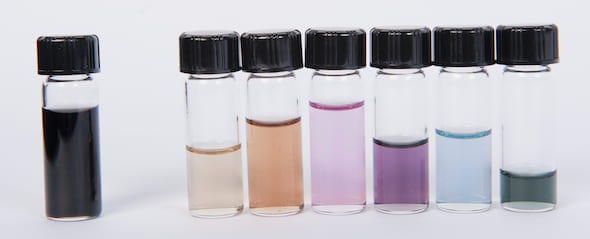Rice researchers tag excitons in search for hues’ clues
Rice University researchers knew the bright colors they saw in their purified armchair nanotubes were unique.
They realized gold and silver nanoparticles could be manipulated to reflect brilliant hues – a property that let artisans who had no notions of “nano” create stained glass windows for medieval cathedrals. Depending on their size, the particles absorbed and emitted light of particular colors due to a phenomenon known as plasma resonance.
In more recent times, researchers noticed semiconducting nanoparticles, also known as quantum dots, show colors determined by their size-dependent band gaps.
But plasma resonance happens at wavelengths outside the visible spectrum in metallic carbon nanotubes. And armchair nanotubes don’t have band gaps. Something else was up.

Armchair-enriched batches of nanotubes show their colors in an array of varying types. The vial at left is a mix of nanotubes straight from the furnace, suspended in liquid. The vials at right show nanotubes after separation through ultracentrifugation. Excitons absorb light in particular frequencies that depend on the diameter of the tube; the mix of colors not absorbed are what the eye sees. (Credit: Erik Hároz/Rice University)
The Rice lab of physicist Junichiro Kono ultimately determined that “excitons” are the source of color in batches of pure armchair nanotubes suspended in solution.
The study by graduate student and lead author Erik Hároz; Kono, a professor of electrical and computer engineering and of physics and astronomy; and their co-authors appears in the online edition of the Journal of the American Chemical Society.
The results seem counterintuitive, Kono said, because excitons are characteristic of semiconductors, not metals. Armchair carbon nanotubes — so named for the U-shaped configuration of the atoms at their uncapped tips — are one-dimensional metals and have no band gap. This means electrons flow from one end to the other with little resistivity, the very property that may someday make armchair quantum wires possible.
The Rice researchers show armchair nanotubes absorb light like semiconductors. An electron is promoted from an immobile state to a conducting state by absorbing photons and leaving behind a positively charged “hole,” Kono said. The new electron-hole pair forms an exciton, a charge-neutral, hydrogen-like object. “The excitons are created by the absorption of a particular wavelength of light,” Hároz said. “What your eye sees is the light that’s left over; the nanotubes take a portion of the visible spectrum out.” The diameter of the nanotube determines which parts of the visible spectrum are absorbed; this absorption accounts for the rainbow of colors seen among different batches of nanotubes.
Kono said that while armchair nanotubes don’t have band gaps, they do have a unique electronic structure that favors particular wavelengths for light absorption.
“In armchair nanotubes, the conduction and valence bands touch each other,” Kono said. “The one-dimensionality, combined with its unique energy dispersion, makes it a metal. But the bands develop what’s called a van Hove singularity,” which appears as a peak in the density of states in a one-dimensional solid. “So there are lots of electronic states concentrated around this singularity.”
Exciton resonance tends to occur around these singularities when hit with light, and the stronger the resonance, the more distinguished the color. “It’s an unusual quality of these particular one-dimensional materials that these excitons can actually exist,” Hároz said. “In most metals, that’s not possible; there’s not enough Coulomb interaction between the electron and the hole for an exciton to be stable.”
The new paper follows on the heels of work by Kono and his team to create batches of pure single-walled carbon nanotubes through ultracentrifugation. In that process, nanotubes were spun in a mix of solutions with different densities up to 250,000 times the force of gravity. The tubes naturally gravitated toward separated solutions that matched their own densities to create a colorful “nano parfait.”
As a byproduct of their current work, the researchers proved their ability to produce purified armchair nanotubes from a variety of synthesis techniques. They now hope to extend their investigation of the optical properties of armchairs beyond visible light. “Ultimately, we’d like to make one collective spectrum that includes frequency ranges all the way from ultraviolet to terahertz,” Hároz said. “From that, we can know, optically, almost everything about these nanotubes.”
Co-authors of the paper include Robert Hauge, a distinguished faculty fellow in chemistry at Rice; Rice alumnus Benjamin Lu; and professors Pavel Nikolaev and Sivaram Arepalli of Sungkyunkwan University, Suwon, Korea.
The research was supported by the Department of Energy, the Robert A. Welch Foundation, the Air Force Research Laboratory and the World Class University Program at Sungkyunkwan University.

